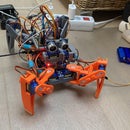Introduction: Simple Logic Gate IC-Tester
Hello everyone
If you make a project with logic circuit IC's it's very likely that you need a lot of them. Imagine a situation where one of them isn't working properly. You solder everything together and power it up but nothing happens. That is very disappointing. It's hard to find the reason for that but it can be even harder to replace that part then with an IC that is working. You probably wished then that you had tested your IC's before.
In the next few steps I am going to show you how you can make your wish come true. I called it simple logic gate IC-tester because everything you need is very basic and you don't need more than a rough understanding of how electricity works in order to understand this instructable.
Supplies
- 1x Circuit Board (I've used 5cm x 7cm)
- 2x Buttons
- 1x 28-pin socket
- 2 male header connectors
- 4x 3mm green LED
- 4x 3mm blue LED
- 2x 1k ohm resistor
- 4x 680 ohm resistor
- 4x 470 ohm resistor
- wires
- soldering iron (or access to one)
Step 1: General Principle
Basically, logic gates work by having two inputs and an output based on the state of the two inputs. In the left figure, I have marked the inputs in yellow and the outputs in blue. In the right figure I marked the inputs yellow and the outputs green. If you start from the top left point of both IC's you see that there are two different arrangements of the pins. On one the output comes first and then the inputs and on the other it is the other way round.
What logic the IC's contain is therefore not so important. I wanted to test NOR-gates with the blue arrangement and AND-gates with the green one but every logic gate IC with the same pinout can be tested with it.
VCC (in our case 5V) is connected to the upper right and GND to the lower left. This is the same for most IC's.
Step 2: Circuit
The reasoning behind the principle was that it is easy to say that everything works if the LEDs all show the same behavior. So one button had to be connected to each input A and the other button had to be connected to each input B. The LED's are connected to the output accordingly and so that they are not damaged a series resistor is also necessary. For the blue LED lamps this needs 680 Ohm. With the green ones only one of 470 Ohm is necessary. So that the state of the buttons is clear, the 1k Ohm resistor pulls the inputs of the IC's in digital language to 0. For the current connection there are the two male header pins, to which one can connect jumper wires. I lead them to a breadboard on which is a voltage regulator. So I don't limit the connection only to batteries or a laptop connection.
Now you just have to solder everything together and you can use it. It is important to know that components can be damaged if you insert them incorrectly and it is also a big risk to insert the components during operation, because then you have less time to check if everything is inserted correctly. Also, only one IC can be plugged in at a time, otherwise the cases would overlap.
Have fun with your simple logic gate IC tester!













